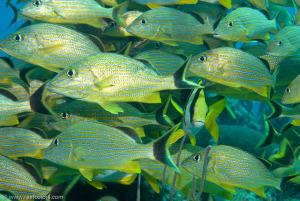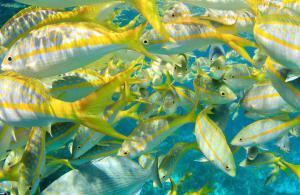
blue-striped grunt (Haemulon sciurus)
Coral reef fishes are wonderfully diverse in size, form, and function, as well as their need for different habitats throughout the life cycle. Some species spend all of their life in the same kind of coral habitat, while others need different places to breed and feed.
Fishes requiring different habitats as they progress through life often have what we call ‘nurseries’ in which adults lay eggs and the subsequent juveniles remain, and these places are often dominated by mangroves or seagrasses (i.e., they are not part of the coral reef).
While we’ve known for quite some time that when these nursery habitats are not around, adjacent coral reefs have few, if any, of these nursery-dependent species. What we haven’t known until now is just how far the influence of nurseries extends along a coral reef.
In other words, if a nursery is present, just how many new recruits do different areas of a reef receive from it?

schoolmaster (Lutjanus apodus) ©ryanphotographic.com
To answer this question, my colleagues (led by Ivan Nagelkerken) and I examined a dataset that Ivan had collected earlier in many coral reefs of the Caribbean Sea (Aruba, Curaçao, Grand Cayman, and Bermuda). Selecting areas where a single nursery existed, and then measuring the density, biomass, and species composition along the reef at increasing distances from the nursery, we were able to test just how far this ‘replenishment’ effect extended. Our results have just been published in Marine Ecology Progress Series.
While we weren’t surprised by the observation that no-dependence and low-dependence (in terms of nurseries) species had no to little spatial signal in either their densities or biomass, the (highly) nursery-dependent species responded strongly to how far away they were from the nursery itself. In fact, both the density and biomass of these species dropped sharply after about only 4 km from the nursery, meaning that any replenishment effects were next to zero for reefs beyond this 4 km threshold.

yellow-tail snapper (Ocyurus chrysurus)
Certainly, some of these nursery-dependent species do make it to reefs farther away, but typically only via sporadic (and risky) adult migration. We also determined that the community structure of reefs closer to nurseries was much different to those farther away as a result of this replenishment gradient.
So what does this mean for conservation? Several management implications arise from our work, including the fact that nurseries areas are extremely important to conserve within a coral-reef network. If you stuff up the mangroves and seagrass beds, you risk losing a major component of your reef-fish biota as a consequence.
Second, while our results imply that management of reefs adjacent to nurseries might be a little easier because the effects are limited to within ~ 4 km, it also means that targeted over-exploitation of these areas could end up degrading the fish community along the entirety of the reef more quickly than if the pressure was spread around more evenly.
The take-home message is that just because you have a few nurseries doesn’t necessarily imply that the entire reef-fish community will be fine, because their ability to replenish fish populations over long distances is limited.

